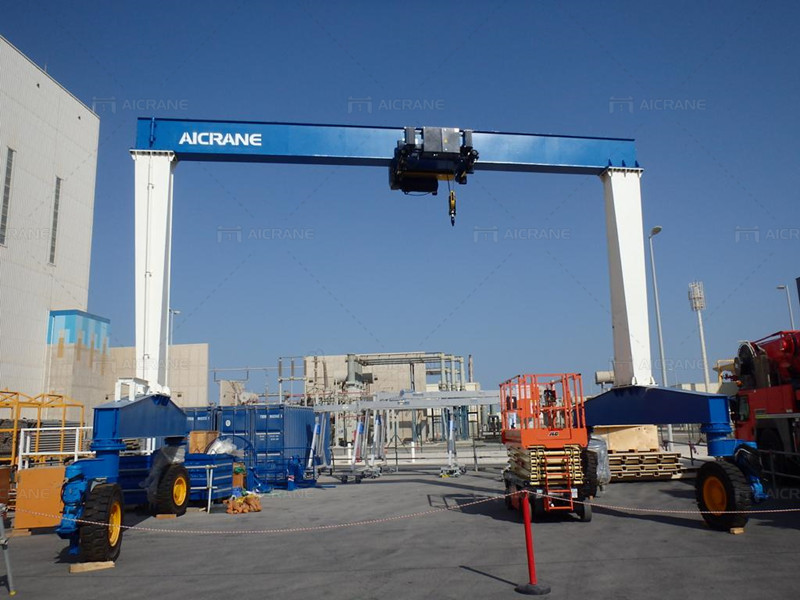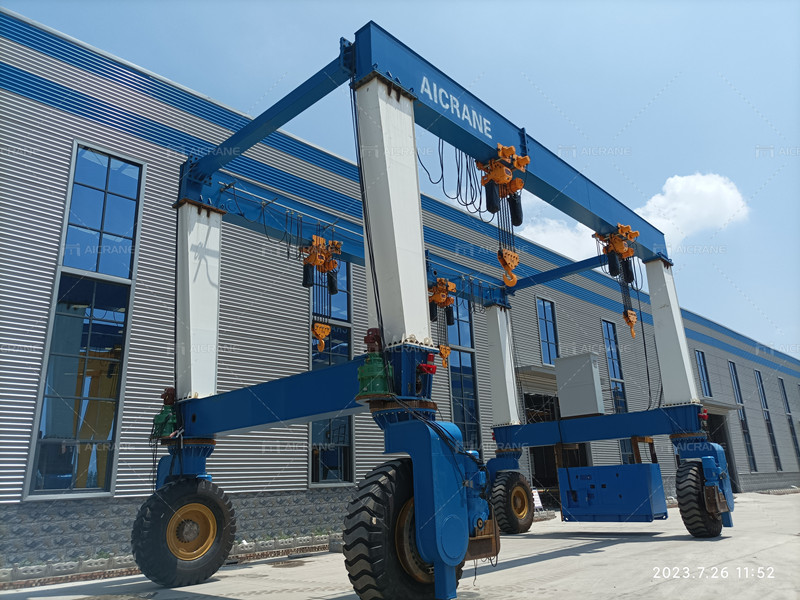A Rubber Tyred Gantry Crane (RTG crane) is a highly versatile, mobile crane system widely used in port and terminal operations for stacking and transporting large cargo containers. Unlike fixed gantry cranes, which are rail-mounted, RTG cranes are equipped with large, robust rubber tires that allow them to move freely across a designated area. This mobility makes RTG cranes invaluable in busy port environments, where flexibility and efficient use of space are critical.

Overview of Rubber Tyred Gantry Cranes
RTG cranes are typically employed to transfer, load, and unload intermodal containers from ships, trucks, or railcars. They operate in container yards, where their ability to move between stacks and position containers precisely enhances both storage efficiency and overall operational flow. These cranes are often preferred in ports due to their unique ability to work in confined areas, maximizing yard space by stacking containers vertically.
Basic Structure and Components of RTG Cranes
A typical rubber tyred gantry crane definition comprises:
Main frame: The core structure that spans the width of container rows, supporting the crane’s movement and lifting mechanisms.
Hoist and trolley: Positioned at the top of the main frame, the hoist and trolley mechanism enables vertical and horizontal movement, allowing containers to be lifted and lowered with precision.
Rubber tires: Positioned at the bottom of the crane, these heavy-duty rubber tires provide maneuverability and flexibility, enabling the crane to move independently across container stacks.
Power supply: While many RTG cranes run on diesel engines, recent innovations have introduced hybrid and electric options to reduce fuel consumption and emissions.
Key Functions of RTG Cranes in Port Operations
The primary role of an RTG crane in port operations is to enhance the movement and stacking of containers, streamlining container logistics and reducing wait times. Specifically, RTG cranes facilitate:
Efficient container stacking: RTGs can stack containers up to seven or eight high, maximizing vertical space in a container yard.
Smooth loading and unloading: These cranes help transfer containers between transportation vehicles (such as trucks and railcars) and storage areas.
Flexible mobility: Unlike rail-mounted gantries, RTGs can move laterally across different rows of containers, adapting to changing operational needs.
Advantages of Using RTG Cranes in Ports
Get your crane from a reliable manufacturer like Aicrane is important. Here shows some of the advantages of using RTG cranes in ports:
1. Mobility and Flexibility: The rubber tires of RTG cranes allow them to navigate around containers and adjust to different yard configurations without the constraints of a fixed track.
2. High Stacking Capacity: RTGs container gantry crane can stack containers vertically, optimizing yard space and allowing ports to increase storage density, especially critical for high-traffic terminals.
3. Operational Efficiency: By enabling efficient container transfers, RTGs reduce delays in port activities, allowing faster turnarounds for ships, trucks, and trains.
4. Adaptability to Modern Innovations: Many RTG cranes now integrate hybrid or electric engines, which not only reduce environmental impact but also cut operational costs by minimizing fuel consumption.
5. Cost-Effective Yard Management: Since RTGs do not require the installation of rail tracks, they offer cost savings in both setup and maintenance. They also allow for easy reconfiguration of container yards as storage needs evolve.
Types of Rubber Tyred Gantry Cranes
RTG cranes can vary based on several specifications and technological advancements. Here are the main types commonly found in port operations:
1. Diesel-Powered RTGs: Traditionally powered by diesel engines, these cranes offer strong performance but have high fuel costs and emissions.
2. Hybrid RTGs: Hybrid RTGs combine diesel power with electric systems, resulting in reduced fuel consumption and lower emissions. They are a good middle ground for ports looking to increase efficiency while reducing their environmental footprint.
3. Electric RTGs (eRTGs): Fully electric RTGs use a cable reel or busbar system to receive electricity from a grid. This setup cuts emissions entirely and is particularly advantageous for ports aiming to meet environmental sustainability goals.
4. Automated RTGs (ARTGs): Automation in RTGs allows for remote control or fully autonomous operation, which can significantly increase precision and efficiency. ARTGs also reduce labor costs and improve operational safety, as they minimize human intervention.

Operational Considerations for RTG Cranes in Ports
When implementing RTG cranes in port operations, several considerations come into play:
1. Port Layout and Yard Design: Ports must consider container yard layouts to maximize the efficiency of RTG operations. Stack heights, row width, and maneuvering space all affect how well RTGs can operate.
2. Environmental Impact: For ports aiming to reduce emissions, investing in electric or hybrid RTGs is essential. Some ports are also equipped with renewable energy sources to power their RTG cranes, aligning with global environmental goals.
3. Maintenance and Downtime: Regular maintenance of RTGs is crucial to minimize operational interruptions. Ports often have dedicated teams for preventive maintenance to ensure equipment remains reliable, particularly for high-use RTGs.
4. Training and Skill Requirements: Operating RTGs requires skilled operators who can handle precise movements and navigate container yards effectively. As automation advances, ports also need skilled technicians to oversee automated systems.
Safety Measures for RTG Crane Operations
Safety is paramount in RTG crane operations. Ports enforce stringent safety protocols to ensure the protection of workers and equipment. Key safety measures include:
Routine Inspections: Frequent checks of mechanical and electrical components reduce the risk of breakdowns.
Operator Training: Operators receive comprehensive training in handling rubber tyred gantry cranes, understanding safety protocols, and managing emergency procedures.
Automation for Hazardous Areas: In areas with high foot traffic, automated RTGs help mitigate risks by minimizing the need for human operators.
Anti-Sway Technology: Advanced RTGs incorporate anti-sway mechanisms that stabilize container loads, preventing accidents and improving accuracy.
Future Trends for RTG Cranes in Port Operations
The future of RTG cranes is closely tied to advancements in automation, energy efficiency, and environmental sustainability. Some emerging trends include:
1. Increased Automation: With developments in autonomous technology, RTG cranes are expected to play a larger role in automated port systems. Automation improves operational safety and efficiency, allowing RTGs to work around the clock without human intervention.
2. Green Technology: As ports aim to reduce their environmental footprint, there’s a growing shift toward electric and hybrid RTGs. Many ports are investing in eRTGs that use renewable energy sources, contributing to cleaner operations.
3. Enhanced Connectivity and Monitoring: Modern RTG cranes are increasingly integrated with IoT (Internet of Things) systems, allowing real-time monitoring and diagnostics. This connectivity helps optimize crane operations by providing insights into fuel consumption, maintenance needs, and operational efficiency.
4. Integration with Smart Port Systems: RTG cranes are becoming essential components in smart port ecosystems, where data-driven insights and real-time communication between equipment enhance productivity and streamline container flow.
Rubber tyred gantry cranes are indispensable in port operations, offering the flexibility and efficiency needed for high-density container storage and smooth cargo handling. With their ability to stack containers, maneuver around container yards, and adapt to modern automation and energy solutions, RTG cranes are key to streamlining port operations. As the industry evolves, advancements in RTG technology will continue to play a critical role in the future of port logistics, especially as ports prioritize sustainability and operational efficiency.